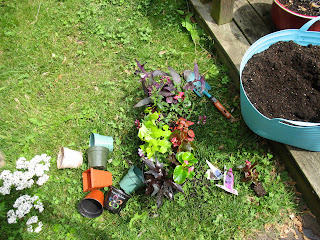So finally, the water feature.
This is the container, minus its usual inhabitant.
I already have a little pump to circulate the water, prevent
algae growth and discourage mosquitos from
breeding in it.
My plan was to have some tall papyrus, or else big taro, or best of all a
giant astilboides.
None of these were available at the pond
shop and I ended up with this white rush.
Now that I look at it, I
wish I had gone with the sweet flag ...
or had driven the extra distance to Sheridan Nurseries. Coulda
shoulda woulda.
This Cyperus papyrus 'Baby Tut' actually came from Loblaws.
I also bought a Canna 'Australis', which is supposed to reach 32-40". Maybe this will alleviate my disappointment with the rushes. However, a few days later I went to Costco where they were selling massive
canna lilies for about half the price I paid for this pipsqueak.
I love the parrot's feather (Myriophyllum aquatica) -- it just hangs around oxygenating and is supposed to multiply like crazy.
There's also a tiny taro that overwintered as an unhappy house plant.
One piece of useful information I did acquire at the pond shop was not to use regular potting soil. Also, the plants shouldn't be submerged under more than 4 inches of water.
So I
elevated the pots by placing other, inverted pots beneath them. I
haven't figured out yet how I'm going to fit my little pump in there
to circulate the water and make it less hospitable to mosquito larvae.
The pond guy suggested not bothering with the pump and throwing in a
couple of goldfish instead to keep things clean -- but it seems like a depressing life for them. Even if the racoons don't get them
right away.
He also recommended that pond plant fertilizer tabs be pushed into the soil. PondTabbs, for example, are 10-14-8 and are supposed to be safe for fish while not releasing algae-promoting chemicals into the water.
I
ended up not buying special pond soil because it only came in huge bags and was expensive. I gather it is made of diatomaceous earth. Some people like to use kitty litter; still others prefer a product called
Oil Dri that is used to clean up oil spills.
I went with the kitty litter.
Aquatic plants like a clay soil, and that's what (old-fashioned) cat litter is made of. Don't try any other kind -- especially not the clumping variety!
Pebbles on top help keep the soil/litter in the containers.
It would be better to use special plant baskets --
-- but these were pretty expensive. I think I'll see if I can use plastic collanders from the Dollar Store.
Most water plants are supposed to want more light than I have in this location, but so far nobody seems to be complaining. The Baby Tut papyrus in particular is happy as a clam, and is taking over the joint.
Since the white rush wasn't doing it for me, I added some "borrowed
scenery" by positioning a potted Dracena marginata behind my container.
















































